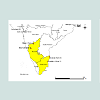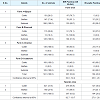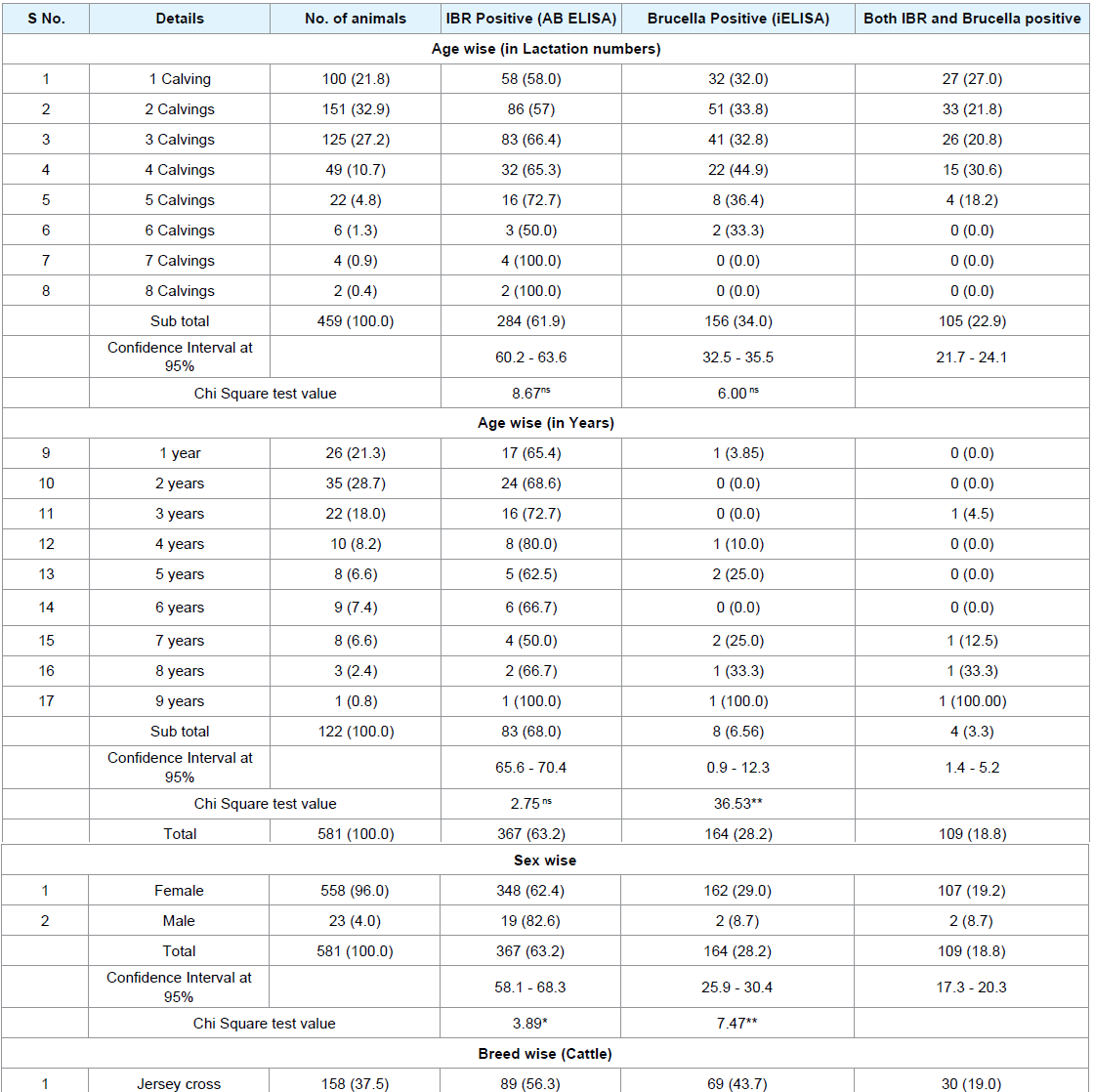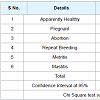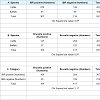Journal of Epidemiology & Health Care
Download PDF
Research Article
*Address for Correspondence: Paramanandham Krishnamoorthy, Indian Council of Agricultural Research - National Institute of Veterinary Epidemiology and Disease Informatics, Ramagondanahalli, Post Box No. 6450, Yelahanka, Bengaluru, Karnataka 560064, India,, E-mail: krishvet@gmail.com
Citation: Krishnamoorthy P, Govindaraj GN, Shome R, Patil SS, Shome BR. Risk Analysis of Concurrent Occurrence of Infectious Bovine Rhinotracheitis and Brucellosis in Organized Dairy Farms. J Epidemiol Health Care 2016;1(1): 8.
Copyright © 2016 Krishnamoorthy P, et al. This is an open access article distributed under the Creative Commons Attribution License, which permits unrestricted use, distribution, and reproduction in any medium, provided the original work is properly cited.
Journal of Epidemiology & Health Care | Volume: 1, Issue: 1
Risk Analysis of Concurrent Occurrence of Infectious Bovine Rhinotracheitis and Brucellosis in Organized Dairy Farms
Paramanandham Krishnamoorthy*, Gurappa Naidu Govindaraj, Rajeswari Shome, Sharanagouda Shiddanagouda Patil and Bibek Ranjan Shome
- Indian Council of Agricultural Research - National Institute of Veterinary Epidemiology and Disease Informatics, Ramagondanahalli, Post Box No. 6450, Yelahanka, Bengaluru, Karnataka 560064, India
*Address for Correspondence: Paramanandham Krishnamoorthy, Indian Council of Agricultural Research - National Institute of Veterinary Epidemiology and Disease Informatics, Ramagondanahalli, Post Box No. 6450, Yelahanka, Bengaluru, Karnataka 560064, India,, E-mail: krishvet@gmail.com
Citation: Krishnamoorthy P, Govindaraj GN, Shome R, Patil SS, Shome BR. Risk Analysis of Concurrent Occurrence of Infectious Bovine Rhinotracheitis and Brucellosis in Organized Dairy Farms. J Epidemiol Health Care 2016;1(1): 8.
Copyright © 2016 Krishnamoorthy P, et al. This is an open access article distributed under the Creative Commons Attribution License, which permits unrestricted use, distribution, and reproduction in any medium, provided the original work is properly cited.
Journal of Epidemiology & Health Care | Volume: 1, Issue: 1
Submission: 30 July, 2016 | Accepted: 01 December, 2016 | Published: 10 December, 2016
Selection of farms
The seroprevalence of IBR and brucella antibodies based on age, sex and breed wise in the organized dairy farms is given in Table 2 On the basis of age, the bovines with higher lactation numbers, above 4 calvings (73.53%) and above 4 years of age (69.89%) showed increased percentage positivity for IBR. There was no significant difference between different age groups indicating association of age of animals with occurrence of IBR and brucellosis in dairy animals. Based on sex, the males revealed higher positivity (82.6%) for IBR whereas, females were positive for brucellosis (29.0%) and positive for both IBR and brucellosis (19.2%). Breed wise analysis revealed high percentage positivity for IBR and brucellosis were observed in Gir and Tharparkar breeds in indigenous breeds of cattle, respectively. In crossbred cattle, more percentage positivity for IBR and both positivity were observed in Holstein Friesian cross and for brucellosis in Jersey cross than the indigenous cattle breeds. In buffalo breeds, Murrah showed more percentage positivity for brucellosis and both positivity. There was significant difference between sex, breed with IBR, brucellosis seroprevalence by Chi square test, which indicated that there was association between these factors and occurrence of IBR and brucellosis in bovines.
The seroprevalence of IBR and brucellosis based on animal health status in the organized dairy farms is given in Table 3. The animals with history of repeat breeding were high in number in these dairy farms. IBR seroprevalence was high in aborted animals when compared with animals of other reproductive disorders. There was significant difference between animal health status and IBR, brucellosis seropositivity, indicating association between them.
The measures of association between species and IBR, brucellosis seropositivity is given in Table 4. The relative risk for occurrence of IBR and brucellosis were 1.15 and 1.30 times in cattle more than the buffalo. Risk difference was 9 per 100 animals for IBR and 7 per 100 animals for brucellosis in cattle than the buffaloes. The attributable risk was 13.25% and 23.34% more for IBR and brucellosis in cattle when compared to buffaloes. The Odds ratio for IBR and brucellosis seropositivity was 1.44 times more in cattle than buffaloes. However, the Odds ratio of IBR seropositivity occurrence was 1.22 times more than brucellosis in the dairy animals. The Chi square test results revealed no significance difference between species and occurrence of IBR and Brucellosis, which indicated that the cattle and buffaloes having no dependency for acquiring the IBR and brucellosis infections in organized dairy farms. The Kappa value was 0.033 for IBR seropositive to become brucellosis seropositive, which indicated that there was slight agreement between these two diseases in cattle and buffaloes. The risk analysis indicated that there was variation between the host factors and occurrence of these two diseases in dairy animals and needs to take up the preventive and control measures for these diseases.
Abstract
In the present study, epidemiology and risk analysis of Infectious Bovine Rhinotracheitis (IBR) and brucellosis in organized dairy farms was done. Sera samples (cattle (421) and buffalo (160)) were collected randomly from dairy farms viz., Bijapur (Farm A), Dharwad (Farm B) in Karnataka, Chennai (Farm C), Cuddalore (Farm D) in Tamilnadu state, India. Apparent and true prevalence were 63.2% and 67.9%, 28.2% and 30.3%, 18.8% and 20.2% for IBR, Brucella and both antibodies, respectively. Higher seroprevalence of IBR and brucellosis were in Farm B (81.3%) and Farm D (60.6%), respectively. Higher age groups and crossbred bovines showed increased IBR and brucellosis seroprevalence. Seropositivity for brucellosis was high in Females (29.0%) whereas, IBR was high in males (82.6%). Relative risk in cattle were 1.30 (brucellosis) and 1.15 (IBR) times more than buffaloes. Attributable risk of IBR and brucellosis were 23.34% and 13.25% in cattle than buffaloes. Risk difference of IBR and brucellosis were 9/100 and 7/100 cattle, than buffaloes. There was association for occurrence of IBR and brucellosis based on age (brucellosis only), sex, breed, animal health status, indicating influence of host factors in concurrent occurrence of these diseases. There is need for IBR vaccination, zoosanitary measures and strengthening of brucellosis control in organized dairy farms for better productivity and profitable dairying in India.Keywords
Seroprevalence; Epidemiology; IBR; Brucellosis; Organized dairy farmsIntroduction
The reproductive problems and diseases are the main impediments for the profitable dairying in India (abortions, repeat breeding, retained placenta, anoestrus, metritis, etc.). There are several bacterial and viral infectious agents like Brucella abortus, Bovine herpes virus-1 (BoHV-1), Leptospira spp. etc. may be responsible for causing abortions in dairy animals [1,2]. Infectious bovine rhinotracheitis (IBR), a viral disease caused by BoHV-1, which causes respiratory signs and abortions in dairy animals. It causes latent infectionand transient immunosuppression which may lead to infectious rhinotracheitis and infectious pustular vulvovaginitis in bovines. It also causes huge economic losses due to abortions, repeat breeding and low milk production in affected animals. A high prevalence of antibodies against BoHV-1 in cattle (50.9%) and buffaloes (52.5%) has been recorded in India [3] and BoHV-1 was also isolated from bovine semen samples [4]. Presently, there is no IBR vaccination for cattle and buffaloes being used in India as reported earlier [5].Brucellosis is a zoonotic bacterial disease of livestock predominantly caused by Brucella abortus, having high zoonotic impact. Its transmission to humans occurs mainly by the consumption of raw dairy products and by direct contact with the skin or mucosa during parturition and abortion. Cattle (Bos taurus) are natural hosts for Brucella abortus, while sheep (Ovis aries) and goats (Capra hircus) for B. melitensis and B. ovis. In particular, the disease is characterizedby abortions, infertility and reduced milk yield in cattle and buffaloes. A high seroprevalence of bovine brucellosis (17%) has been reported in Indian dairy herds with the history of abortions [1] and the organism could also be isolated from aborted material in cattle [6]. Brucellosis is a self limiting disease but causes abortions in cattle and buffaloes of organized dairy farms and causes great economic loss to the dairy farmers in India [5].
In a recent study, the seroprevalence of IBR, brucella and both antibodies were 61.54%, 11.63% and 10.58%, respectively in organized dairy farms in southern India [5]. The IBR seroprevalence in organized dairy farms in India was reported to be 61.6% [7]. Manystudies are available on the seroprevalence of IBR and brucellosis in organized dairy farms separately [7] and in a recent study on concurrent prevalence of IBR and brucellosis based on age, sex, species, breed and animal health status has been reported [5]. There are limited studies on the epidemiological and risk analysis of IBR and brucellosis in bovines of organized dairy farms. These studies are important for better understanding of these disease and their relationships. Hence, the present study was undertaken to know the epidemiology and risk factors for IBR and brucellosis seroprevalence in organized dairy farms in Karnataka and Tamilnadu states in India.
Materials and Methods
A cross-sectional study was conducted during 2014-15 in four organized dairy farms, comprising two farms each in Karnataka (Farm A-Bijapur; Farm B-Dharwad) and in Tamilnadu (Farm C-Chennai; Farm D-Cuddalore) in southern India, which were selected randomlyfor this study. Organized dairy farms means the cattle or buffaloes were reared under intensive system of management with systematic production management systems and maintained mainly for milk production. The exact geographical locations of four dairy farms was collected and mapped by using Quantum GIS software version 2.10. The history of the animals like species, age, sex, breed, animal health status and managemental practices, were collected from these organized dairy farms. The history included occurrence of abortions, post abortion complication, infertility within the past three years were also collected.
Sample collection
For serological investigations, a total of 581 serum samples, from cattle (421) and buffaloes (160), were collected from animals via jugular venipuncture for screening against IBR and brucella antibodies. The blood samples were collected by using sterile serum vacutainer tubes coated with silicone and micronized silicaparticles to accelerate clotting, and multi-sample vacutainer needles (Becton and Dickenson Company, USA). The serum was separated by centrifugation at 560 g for 20 minutes. All serum samples were stored at -20 °C until used for testing. Based on sex, 23 male and 558 female samples were collected. The animals were classified based on age in years for bovines having date of birth and bovines not having date of birth, the number of lactations was considered to implicitly derive the age. Based on breeds in cattle, Jersey cross (158), Holstein Friesian cross (138), Deoni (36), Sahiwal (29), Gir (28), Kangayam (16), Rathi (8), Tharparkar (8) and among buffalo breeds, Murrah (157), Jaffrabadi (3) were tested. Based on animal health status and reproductive history, the animals were classified as apparently healthy (421), pregnant (48), repeat breeding (78), mastitis (16), abortions (13) and metritis (5).
Infectious bovine rhinotracheitis screening
The seroprevalence of IBR was carried out by detection of antibodies against BHV-1 virus from serum using Avidin Biotin Enzyme Linked Immunosorbent Assay (AB-ELISA) kit developed by ICAR - NIVEDI, Bengaluru, Karnataka. The sensitivity and specificity of the AB ELISA were 98 and 95 per cent respectively. This is the only indigenously developed kit as per World Organisation of Animal Health standards [8] and available for screening IBR in India.
Brucellosis screening
Diagnosis of brucellosis from serum on the basis of detection of antibodies against Brucella abortus was carried out by using an indirect ELISA (iELISA) kit developed by ICAR-NIVEDI, Bengaluru, Karnataka. The test has been standardized using smooth lipopolysaccharide antigen from a standard strain of Brucella abortus S99 and recombinant protein G conjugated with Horse radish peroxidase as per World Organisation for Animal Health standards [8]. The sensitivity and specificity of the test were 98 and 95% in cattle and 92 and 98% in buffaloes, respectively. The use ofsmooth lipopolysaccharide antigen from Brucella abortus S99 strain in iELISA instead of crude antigen helps to detect antibodies against other smooth species such as B. melitensis and B. suis. The use of protein G conjugate, a common conjugate was advantageous over using different conjugates, protocols for different livestock species and can be used for screening brucellosis in cattle, buffalo, sheep, goat, pigs and humans. The details of the iELISA kit and test protocol are described earlier [9].
Statistical analysis
The apparent prevalence and true prevalence was estimated as per the following formula [10]. (i) Apparent prevalence = number of positive animals/number of tested animals. (ii) True prevalence = [apparent prevalence + (specificity -1)] / [(sensitivity + specificity) - 1]. The data analysis was carried by calculating percentage positivity for IBR, Brucellosis and both these diseases. The one way analysis of variance was used for analysis between the farm wise seroprevalence for IBR, brucellosis and both positivity. The Chi square test of independence was calculated to measure the association between the age, breed, sex, animal health status with IBR and brucellosis occurrence as per earlier method described [11] and by using Statistical Analysis System (SAS) Software version 9.3 (SAS India Ltd, Mumbai, India). The risk analysis between species and, IBR, brucellosis positive number of animals, like relative risk, risk difference, attributable risk and Odds ratio was calculated as described method earlier [10].
Results
The location of the four organized dairy farms in Karnataka and Tamil Nadu state in India is depicted in Figure 1. The seroprevalence of IBR and brucellosis based on farm and species wise in the four organized dairy farms is given in Table 1. The overall apparentprevalence of IBR, brucellosis and both the diseases in organized dairy farms were 63.2%, 28.2% and 18.8%, respectively, where as true prevalence were 67.9%, 30.3% and 20.2 %, respectively. No significant difference was observed between the farms for seroprevalence of IBR, brucellosis and both positivity. The farm wise analysis showed Farm B had high percentage positivity for IBR (81.3 %) and Farm D for brucellosis (60.6 %) and both positivity (25.7 %). Based on species, cattle and buffalo showed 65.6% and 56.9% positivity for IBR antibodies, and 30.2% and 23.1% positivity for brucella antibodies,respectively. There was no significant difference between the species for seroprevalence of IBR and brucellosis.Discussion
Earlier literature indicated that the seroprevalence of IBR in organized dairy farms in India ranged from 51 to 65% [3,5,12] and concurred with the present study for IBR (63.2%). In the present study, the seroprevalence of IBR is maintained within the range, however the seroprevalence showed slight increase from 51.4% during 1996 [3] to 63.2% in 2015 which might be due to non-availability of IBR vaccine in India. The high prevalence indicates the importance of the disease in bovines in India. Across farms, Farm B showed higher seroprevalence of IBR (81.3%) indicating variation in prevalence levels. Further, in the all the farms screened in this study practiced artificial insemination, procured from government agencies whereas in Farm B, regularly practiced natural breeding which might be the reason for spread of IBR in this farm. The higher seroprevalence of IBR observed in buffaloes across the farms studied and might due to the purchasing of Murrah buffaloes from northern states of India viz., Haryana and Punjab by these farms, which have higher seroprevalence of IBR. The seroprevalence of brucellosis was higher in Farm D which might be due to inflow of animals from farms with unknown history on disease status, the poor management practices and zoo sanitary measures adopted in these farms. The seroprevalence of brucellosis observed in Farm C-Chennai was 17.4% and it was higher than the previous report which indicated seroprevalence of 6.7% by iELISA in an organized dairy farm with cattle in Chennai [13]. This might be due to the spread of the brucella infection from animals to animalsover the period of time, since the culling of infected animals is not practiced in the farm. This is also due to the social customs and beliefs prevailing in India, in which the people worship cow as god and slaughter of cow are banned in these two states. Perusal of the literature indicated that the prevalence of brucellosis in India varied across the states. In Gujarat, it was ranged from 8.98 to 44.00% [14,15], whereas 17% in southern India [1], 6.3% in Madhya Pradesh and 12.9-57.3% in Punjab [16-8]. The seroprevalence of brucellosis in dairy animals varied across the geographical regions in India. In other countries, seroprevalence of brucellosis was reported to be 3.1%in Ethiopia, 6.5% in Jordan, 8.4% in Cameroon, 32.92 to 39.45% in Turkey, 8% in Pakistan, 35.8% in China, 42.5% in England and 62.5 to 85.7% in Egypt [19-26].The highest number of seropositivity was observed in cattle for both IBR and brucellosis compared to buffaloes. Seroprevalence of IBR in cattle and buffaloes were 50.9% and 52.5%; 60.46% and 62.39%; 59.30% and 67.08%, respectively as per earlier reports and corroborated with the present study [3,5,12]. In India, seroprevalenceof antibodies against BoHV-1 was reported to be 50.9% in cattle and 2.75 to 81.0% in buffaloes [3,27,28] and concurred with the present study. The age wise analysis showed increased seropositivity in higher age group for IBR and brucellosis which might be due to reduced immune response in aged animals. There was association between the age of the bovines with occurrence of brucellosis in dairy farms indicating the susceptibility for the diseases across the age groups. The seroprevalence was higher in males for IBR and in females for brucellosis. The male and female animals showed significant (P<0.05) difference in test for independency for IBR and highly significant (P<0.01) difference for brucella antibodies and indicating association in susceptibility to these diseases among males and females. The crossbred cattle showed increased seroprevalence for IBR, brucella and both antibodies when compared to indigenous breeds of cattle. This might be due to increased susceptibility to infections in crossbred cattle and also chance of spread of diseases by infected bull semen as majority of the farms are artificially inseminated [5]. Further, the genetic nature of indigenous breeds which may be resistant to the diseases than the crossbred animals. Based on Animal health tatus, the bovines with history of abortion (69.2%) and mastitis (68.8%) showed increased seroprevalence for IBR and brucellosis,respectively. There was highly significant (P<0.01) difference for animal health status and IBR, Brucellosis seroprevalence indicating the association with occurrence of this diseases with reproductive problems. Previous report indicated that there was association of IBR with bovine abortion and it was recorded as 55.4% from aborted crossbred cows [3] and corroborated with the present study.
The relative risk of occurrence of IBR and brucellosis was higher in cattle than buffaloes which might be due to the resistance nature of indigenous breeds of buffalo than the cattle (Jersey and Holstein Friesian cross) reared by organized dairy farms. The risk difference showed chance of occurrence of IBR (9 in 100) was more thanbrucellosis (7 in 100) in cattle compared to buffaloes. The attributable risk also revealed the more chance of occurrence of these diseases in cattle than buffaloes. The Odds ratio was 1.44 times high in cattle implying the more chance of occurrence of IBR and brucellosis in this species. The Odds ratio between the occurrence of IBR and brucellosis showed the chance of IBR is 1.22 times more than brucellosis in animals and indicated there was no association for occurrence of these two diseases in dairy animals. However, the Kappa statistics showed that there was a slight agreement between the IBR and Brucellosis diseases occurrence in dairy animals. This indicated that these two disease occurrence might be slightly related. The measures of association between age and brucellosis; sex, breed and animal health status with IBR, brucellosis occurrence showed dependency which might be the reasons for occurrence these diseases in particular age, sex, breed and animal health status. There are no previous studies available on risk analysis for IBR and brucellosis seroprevalence in organized dairy farms to compare the results obtained in the present study.
There is a limitation in this study that the AB-ELISA kit used for detection of IBR is having antigen for the detection of BoHV-1 but used for detection of bubaline Herpes virus-1 in water buffaloes. The IBR antibodies was high compared to Brucella antibodies and it might be due to awareness on management practices followed by dairy farm owners and also by implementation of brucellosis control programmes by central and state Governments. After BoHV-1 infection the virus becomes latent in ganglions and the animals remain seropositive for rest of the life, the virus can be reactivated upon stress and such animals are likely to shed the virus intermittently into the environment [12]. There is no vaccination for IBR in India and the seropositivity indicates the present or latent infection in animals. The higher percentage of seropositivity of IBR in all age groups and breeds indicated the natural circulation of the BoHV-1 virus in the animal population and as reported earlier [7]. Further, the bovines in these farms are reared by intensive system and head to head system of housing which may also favours the spread of these disease in the bovines. The review of literature on the status of brucellosis in organized dairy farms with a history of abortions using RBPT and ELISA revealed seropositive animals were 13.78 and 22.18%, respectively [12], however, slightly higher prevalence (28.2%) was observed in this study. There are several factors playing a possible role for the spread of disease viz unrestricted movement of animals, procurement of animals without proper screening, absence of quarantine before entry to the main herd, lack of prophylactic measures like vaccination, etc. Eradication of brucellosis in the organized dairy farms may be possible by application of test-andremove principle, but non-acceptance of this strategy will hinder its control in India. However, to control brucellosis, a nucleus of brucellosis free bovines may be formed with less contact of reservoirs and continuous monitoring of the health status of all bovines rearedfor breeding purposes. Many measures to control brucellosis and IBR in organized dairy farms has been described earlier [5] but scrupulous following of the same is important. Further, brucellosis is self-limiting infection, its prevalence in the organized dairy farms mainly depends upon the protocol adopted for procuring animals by the farms as well as zoo-sanitary measures followed. Variation in the incidence of brucellosis in different farms might be due to various levels of biosecurity measures adopted by dairy farm owners.
The high prevalence of IBR than brucellosis in organized dairy farms warrants immediate attention to control the disease by adoption of IBR vaccination strategies. The complementary measures like regular screening of animals against these diseases, culling of positive reactors, strict vaccination, quarantine of animals at the time of procurement, use of semen free from infectious agents and strict implementation of zoo sanitary and biosecurity measures should beadopted in the organized dairy farms to reduce the prevalence level of these diseases. For successful control of brucellosis, implementation of various control regimens including test and removal of affected animals, calfhood vaccination, use of semen obtained from brucella free bull and general hygienic measures need to be adopted in the organized dairy farms. Thus, IBR and brucellosis are important diseases that limits the productivity and hence they have to be effectively controlled for more profitable dairying by organized dairy farms in India.
Acknowledgements
The authors thank Indian Council of Agricultural Research (ICAR) for providing necessary facilities for doing this research work under the Institute funded research project. The necessary support provided by the Former Directors, ICAR-National Institute of Veterinary Epidemiology and Disease Informatics, Bengaluru is also gratefully acknowledged.References
- Isloor S, Renukaradhya GJ, Rajasekhar M (1998) A serological survey of bovine brucellosis in India. Rev Sci Tech 17: 781-785.
- Mariya R, Srivastava SK, Thangapandian E (2007) Seroprevalence of leptospiral antibodies in bovines. Indian Vet J 84: 547-548.
- Renukaradhya GJ, Rajasekhar M, Raghavan R (1996) Prevalence of infectious bovine rhinotracheitis in southern India. Rev Sci Tech 15: 1021-1028.
- Rana SK, Sharma GK (2004) Bovine herpesvirus-1: isolation of virus and development of vaccine. International conference on the Control of infectious animal diseases by vaccination. Buenos Aires, Argentina
- Krishnamoorthy P, Patil S, Shome R, Rahman H (2015) Sero-epidemiology of infectious bovine rhinotracheitis and brucellosis in organized dairy farms in southern India. Indian J Anim Sci 85: 695-700.
- Chahota R, Sharma M, Katoch RC, Verma S, Singh MM, et al. (2003) Brucellosis outbreak in an organized dairy farm involving cows and in contact human beings, in Himachal Pradesh, India. Vet Arch 73: 95-102.
- Patil S, Prajapati A, Krishnamoorthy P, Desai GS, Reddy GBM, et al. (2015) Seroprevalence of infectious bovine rhinotracheitis in organized dairy farms in India. Indian J Anim Res.
- OIE (2008) Manual of diagnostic tests and vaccines for terrestrial animals (5th edn). World Organisation for Animal Health, Paris, France.
- Shome R, Padmashree BS, Krithiga N, Triveni K, Sahay S, et al. (2014) Bovine brucellosis in organized farms of India - an assessment of diagnostic assays and risk factors. Adv Anim Vet Sci 2: 557-564.
- Thrushfield MV (2005) Veterinary Epidemiology (3rd edn). Blackwell publishing professional, Ames, Iowa, USA.
- Snedecor GW, Cochran WG (1989) Statistical Methods (7th edn). Oxford and IBH publishing company, New Delhi, India.
- Trangadia B, Rana SK, Mukherjee P, Srivnivasan VA (2010) Prevalence of brucellosis and infectious bovine rhinotracheitis in organized dairy farms in India. Trop Anim Health Prod 42: 203-207.
- Rekha VB, Gunaseelan L, Subramanian A, Yale G (2013) A study on bovine brucellosis in an organzied dairy farm. Vet World 6: 681-685.
- Sutariya PH, Kanani AN, Patel HJ, Dave MJ, Parmar GS, et al. (2005) Estimation of prevalence rate of brucellosis in cattle and buffaloes by ELISA testing in Gujarat. National seminar of Assistant to states for control of animal diseases, India.
- Chauhan HC, Chandel BS, Shah NM (2000) Seroprevalence of brucellosis in buffaloes in Gujarat. Indian Vet J 77: 1105-1106.
- Mehra KN, Dhanesar NS, Chaturvedi VK (2000) Seroprevalence of brucellosis in bovines of Madhya Pradesh. Indian Vet J 77: 571-573.
- Dhand NK, Gumber S, Singh BB, Aradhana, Bali MS, et al. (2005) A study on the epidemiology of brucellosis in Punjab (India) using survey toolbox. Rev Sci Tech 24: 879-885.
- Islam MR, Gupta MP, Sidhu PK, Filia G, Saxena HM, et al. (2013) Comparative evaluation of indirect enzyme linked immunosorbent assay, rose bengal plate test, microagglutination test, and polymerase chain reaction for diagnosis of brucellosis in buffaloes. Turk J Vet Anim Sci 37: 306-310.
- Ibrahim N, Belihu K, Lobago F, Bekana M (2009) Sero-prevalence of bovine brucellosis and its risk factors in Jimma zone of Oromia region, South-western Ethiopia. Trop Anim Health Prod 42: 35-40.
- Al-Majali AM, Talafha AQ, Ababneh MM, Ababneh MM (2009) Seroprevalence and risk factors for bovine brucellosis in Jordan. J Vet Sci 10: 61-65.
- Bayemi PH, Webb EC, Nsongka MV, Unger H, Njakoi H (2009) Prevalence of Brucella abortus antibodies in serum of Holstein cattle in Cameroon. Trop Anim Health Prod 41: 141-144.
- Sahin M, Genc O, Unver A, Otlu S (2008) Investigation of bovine brucellosis in the Northeastern Turkey. Trop Anim Health Prod 40: 281-286.
- Hussain I, Arshad MI, Mahmood MS, Akhtar M (2008) Seroprevalence of brucellosis in human, cattle, and buffalo populations in Pakistan. Turk J Vet Anim Sci 32: 315-318.
- Yan BF, Chao YJ, Chen Z, Tian KG, Wang CB, et al. (2008) Serological survey of bovine herpes virus type 1 infection in China. Vet Microbiol 127: 136-141.
- Woodbine KA, Medley GF, Moore SJ, Ramirez-villaescusa AM, Mason S, et al. (2009) A four year longitudinal sero-epidemiological study of bovine herpesvirus type-1 (BHV-1) in adult cattle in 107 unvaccinated herds in south west England. BMC Vet Res 5: 5.
- Mahmoud MA, Mahmoud NA, Allam AM (2009) Investigations on infectious bovine rhinotracheitis in Egyptian cattle and buffaloes. Glob Vet 3: 335-340.
- Sinha BK, Mishra KK, Singh AP, Kumar R (2003) Seroprevalence of infectious bovine rhinotracheitis in Bihar. 4th Asian Buffalo Congress, 25-28 February, New Delhi, India.
- Malmurugan S, Raja A, Saravanabava K, Dorairajan N (2004) Seroprevalence of infectious bovine rhinotracheitis in cattle and buffaloes using avidin-biotin ELISA. Cheiron 33: 146-149.


